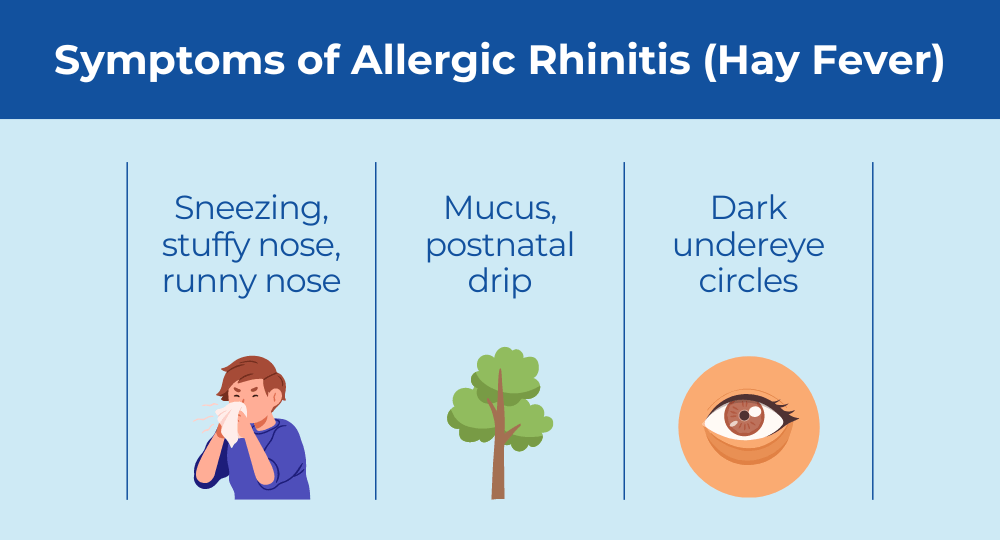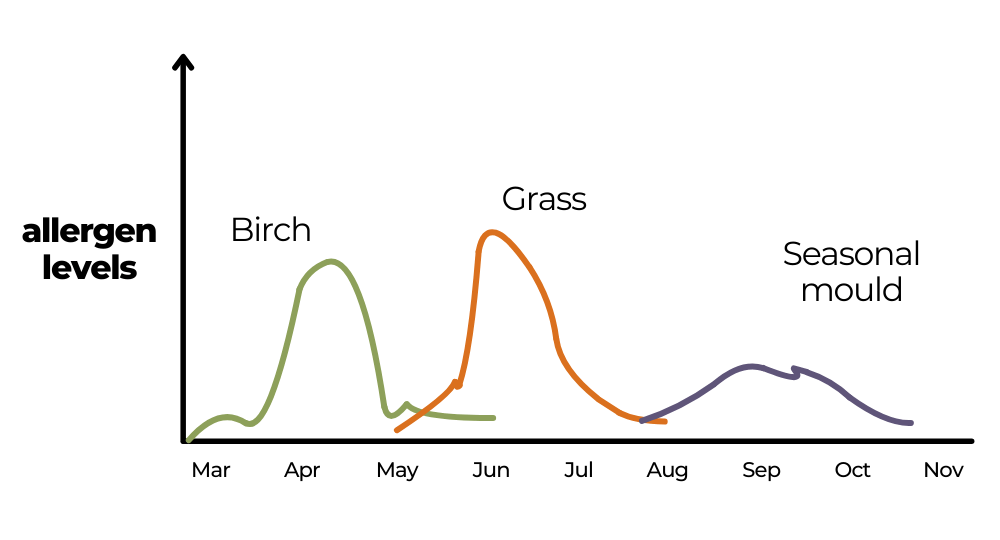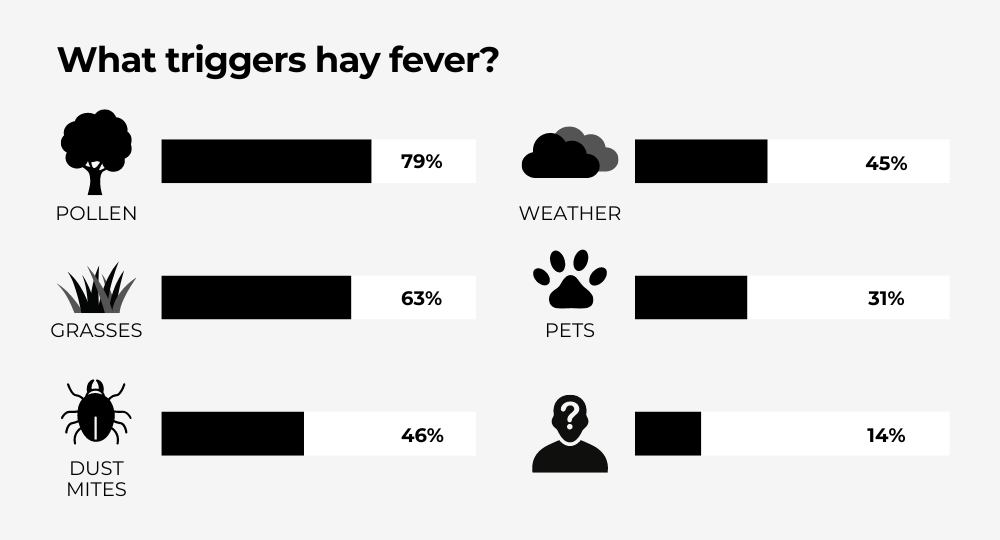What Is The Root Cause Of Hay Fever?
Hay fever, also known as allergic rhinitis, is a common condition affecting millions in the UK and worldwide. Characterized by symptoms such as sneezing, itchy and watery eyes, a runny or blocked nose, and a general feeling of fatigue, hay fever can substantially impact daily life. As the spring and summer months approach, many people deal with these uncomfortable symptoms, prompting a fundamental question: what exactly causes hay fever?
Table of Contents
What causes hay fever?
Hay fever, or allergic rhinitis, is an allergic response activated by airborne allergens. The primary causes are pollen from trees, grasses, and weeds, but other substances like mould spores, pet dander, and dust mites can also play a role. To understand what causes hay fever, it’s essential to investigate how these allergens work together with our immune system and the various factors that influence this condition.

The immune system’s response
Central to hay fever lies the immune system, designed to protect the body from harmful invaders like bacteria and viruses. However, in those with hay fever, the immune system incorrectly links harmless substances, like pollen, as threats. When these allergens enter the body, the immune system overreacts by producing antibodies called Immunoglobulin E (IgE). These antibodies attach to specific cells, releasing chemicals such as histamine into the bloodstream. Histamine is responsible for causing the classic hay fever symptoms: itching, sneezing, runny nose, and watery eyes.
Key allergens
- Pollen: The most common cause of hay fever. Different types of pollen cause symptoms at various times of the year:
- Tree pollen: Common in early spring.
- Grass pollen: Peaks in late spring and summer.
- Weed pollen: Can be prevalent in late summer and autumn.
- Mould spores: These can cause hay fever-like symptoms, especially in damp and humid conditions.
- Pet dander: Proteins found in furry pets’ skin flakes, saliva, and urine can trigger allergic reactions.
- Dust mites: Tiny insects that live in household dust can cause allergic symptoms like hay fever.
Genetic and environmental factors
- Genetics: A family history of allergies or asthma increases the likelihood of developing hay fever. If both parents have allergies, the risk is even higher.
- Environmental exposure: Growing up in rural areas, where exposure to various plants and animals is every day, can sometimes reduce the risk of hay fever. Conversely, urban environments with high pollution levels may exacerbate symptoms.
- Climate and season: Warm, windy days can increase pollen spread, while rain can wash pollen out of the air, temporarily reducing symptoms.
Other contributing factors
- Air Pollution: Pollutants like diesel exhaust particles can exacerbate allergic reactions by making the respiratory system more sensitive to allergens.
- Diet and lifestyle: Some studies suggest that a diet rich in fruits and vegetables may help reduce hay fever symptoms, possibly due to the anti-inflammatory properties of certain nutrients.
Managing hay fever
Understanding what causes hay fever is the first step in managing it effectively. Strategies for reducing symptoms include:
- Avoiding allergens: Monitoring pollen counts and staying indoors when high levels can help.
- Medications: Antihistamines, nasal corticosteroids, and decongestants can provide relief.
- Immunotherapy: For severe cases, allergen-specific immunotherapy (allergy shots) can be effective.
By recognising the causes and triggers of hay fever, individuals can take preemptive steps to manage their symptoms and improve their quality of life. Whether through lifestyle changes, medications, or environmental controls, understanding the root cause of hay fever is crucial in finding effective relief.
What types of pollen cause hay fever?
Hay fever, or allergic rhinitis, is primarily triggered by pollen from various plants. The types of pollen that commonly cause hay fever can be broadly categorised into tree pollen, grass pollen, and weed pollen. Each type has its season and specific characteristics, influencing when and how people experience symptoms.

Tree pollen
Tree pollen is one of the first allergens to appear yearly, typically in early spring. Different trees release pollen at various times, contributing to hay fever symptoms for many individuals. Common tree pollens include:
- Birch: A significant cause of hay fever in the UK, birch pollen season peaks in April and May.
- Oak: Pollen from oak trees is prevalent from April to May.
- Ash: Ash trees release pollen from March to May.
- Alder: Alder pollen is typically present from January to April.
- Hazel: This tree’s pollen season starts in early January and can continue until March.
Grass pollen
Grass pollen is the most common cause of hay fever, affecting many individuals during late spring and summer. Grass pollen season can be divided into two main phases:
- Early season: From mid-May to early June, including grasses like timothy and ryegrass.
- Late season: From early June to July, with perennial ryegrass and other meadow grasses.
Weed pollen
Weed pollen appears later in the year, usually in late summer and autumn. Common weed pollens include:
- Ragweed: Prevalent from late summer to early autumn.
- Nettle: Often causes hay fever symptoms from May to September.
- Mugwort: Mugwort pollen season typically runs from July to September.
- Plantain: This weed releases pollen from May to July.
- Dock: Dock pollen is usually present from May to July.
Pollen count and hay fever symptoms
Pollen counts, which measure pollen concentration in the air, play a crucial role in hay fever symptoms. High pollen counts are often reported during warm, dry, and windy days when pollen is more likely to be airborne. Conversely, rainy days can temporarily reduce pollen levels as rain washes pollen out of the air.
Managing pollen exposure
To manage hay fever symptoms effectively, it’s essential to understand which types of pollen you are allergic to and take steps to minimize exposure:
- Monitor pollen forecasts: Watch daily pollen forecasts and try to stay indoors when counts are high.
- Keep windows closed: Especially during high pollen seasons, keep windows closed to prevent pollen from entering your home.
- Shower and change clothes: After being outdoors, shower and change clothes to remove pollen that may have settled on you.
- Use air purifiers: HEPA filters can help reduce indoor pollen levels.
Dry laundry indoors
Dry your laundry indoors or use a tumble dryer. Hanging clothes outside can allow pollen to settle on them.
Avoid gardening and mowing lawns
- Gardening: Avoid gardening or mowing the lawn during high pollen seasons. If you must do these tasks, wear a mask and protective glasses to reduce exposure.
- Delegate Tasks: Consider delegating these tasks to someone unaffected by hay fever.
Keep pets clean
Pets can carry pollen on their fur. Regularly groom and wipe down your pets to minimise the amount of pollen they bring into the house.
Use allergy-proof covers
Use allergen-proof bedding covers to reduce exposure to pollen and other allergens while you sleep.
Limit outdoor activities
- High pollen days: Limit outdoor activities such as jogging, hiking, or picnicking on days with high pollen counts.
- Vacations: Plan vacations during times of the year when pollen counts are typically lower or choose destinations with lower pollen levels.
Create a pollen-free zone
Designate a room or area in your home as a pollen-free zone. Keep this area clean and pollen-free using air purifiers and cleaning surfaces regularly.
Take precautions during outdoor activities
- Sunglasses: Wear wraparound sunglasses to protect your eyes from pollen.
- Hats: Wear a hat to prevent pollen from settling in your hair.
- Masks: Consider wearing a pollen mask if you need to be outdoors for extended periods.
Plan outdoor activities wisely
- After rain: Plan outdoor activities after it rains, as rain can help wash pollen out of the air.
- Evening activities: Schedule outdoor activities for the evening when pollen counts are typically lower.
What can cause allergic symptoms in autumn and winter?
While pollen allergies are more common in the spring and summer, many people also experience allergic symptoms in the autumn and winter. These symptoms are often triggered by different allergens present during these colder months. Understanding the causes can help manage and alleviate these symptoms.
Mould spores
Mold spores are a common allergen during autumn and winter. As leaves fall and decompose, outdoor mould growth increases. Indoor mould can also thrive in damp areas of the house.
- Outdoor mould: Found in piles of fallen leaves and decaying vegetation.
- Indoor mould: Grows in damp areas such as basements, bathrooms, and around windows.
Dust mites
Dust mites are microscopic creatures that thrive in warm, humid environments. They are present year-round but can become more problematic in winter when homes are sealed and heated, creating an ideal environment for them to flourish.
- Bedding and upholstery: Dust mites commonly reside in mattresses, pillows, carpets, and upholstered furniture.
Pet dander
Pet dander, consisting of tiny flakes of skin shed by cats, dogs, and other animals, can be a significant allergen in the autumn and winter when people spend more time indoors with their pets.
- Indoor pets: Increased indoor time with pets can lead to higher exposure to dander.
Indoor air quality
Poor indoor air quality can exacerbate allergic symptoms during the colder months when homes are sealed to conserve heat.
- Heating systems: Central heating can circulate dust, pet dander, and other allergens.
- Ventilation: Lack of proper ventilation can trap allergens inside the home.
Cockroach allergens
Cockroach droppings, saliva, and body parts can cause allergic reactions and asthma symptoms. Cockroach allergens are more common in urban areas and can become a problem in homes during the winter.
- Urban areas: High-density living conditions can increase exposure to cockroach allergens.
Seasonal changes
The transition from warm to cold weather can trigger non-allergic rhinitis, which causes symptoms like allergies. Changes in temperature, humidity, and barometric pressure trigger this condition.
- Cold air: Cold, dry air can irritate nasal passages and trigger symptoms.
Managing autumn and winter allergies
To manage allergic symptoms during the autumn and winter, consider the following strategies:
- Mould exposure: Clean fallen leaves promptly, use a dehumidifier in damp areas, and clean mouldy areas with bleach.
- Control dust mites: Use allergen-proof covers on mattresses and pillows, wash bedding in hot water weekly, and vacuum regularly with a HEPA-filter vacuum.
- Minimise pet dander: Bathe and groom pets regularly, keep them out of bedrooms, and use air purifiers with HEPA filters.
- Improve indoor air quality: Maintain good ventilation, use air purifiers, and clean heating ducts and filters regularly.
- Manage cockroach allergens: Keep food sealed, clean up crumbs and spills promptly, and use cockroach baits and traps.
- Protect against cold air: Use a humidifier to add moisture to indoor air, and cover your nose and mouth with a scarf when going outside in cold weather.
Manage your hay fever symptoms with The Family Chemist
Hay fever, or allergic rhinitis, can significantly hinder your daily life, particularly during peak pollen seasons. At The Family Chemist, we understand the challenges of managing hay fever symptoms and are here to provide effective solutions to improve your quality of life.
Strategies to manage hay fever symptoms
At The Family Chemist, we offer a range of hay fever products and advice to help you manage your symptoms effectively:
Medications
We provide a variety of over-the-counter and prescription medications tailored to alleviate hay fever symptoms:
- Antihistamines: These help reduce sneezing, itching, and runny nose. Options include tablets, nasal sprays, and eye drops.
- Nasal corticosteroids: Effective for reducing inflammation and relieving nasal symptoms. Available as sprays.
- Decongestants: These can provide short-term relief from a blocked nose. Available as tablets, liquids, and nasal sprays.
Why choose The Family Chemist?
At The Family Chemist, we provide personalised care and effective solutions for managing hay fever. Our team of experienced pharmacists and healthcare professionals is here to support you every step of the way:
- Expert advice: Receive guidance on the best products and strategies to manage your symptoms.
- Convenience: Easy access to various medications and allergy testing services.
- Comprehensive care: From prevention to treatment, we offer a rounded approach to managing hay fever.
- Highly rated, regulated pharmacy: We have over 1,400 Trustpilot reviews and are a GPhC-regulated pharmacy.
Contact us
Don’t let allergies control your life. Visit The Family Chemist for personalised advice and effective hay fever treatments to manage your symptoms. Our friendly and knowledgeable staff are here to help you find relief and enjoy a better quality of life.
FAQs
What are the common symptoms of hay fever?
Common symptoms include sneezing, itchy and watery eyes, runny or blocked nose and fatigue.
How can I reduce my exposure to pollen?
Stay indoors during high pollen counts, use air purifiers, shower and change clothes after being outdoors, and keep windows closed.
What medications can help with hayfever?
Antihistamines, nasal corticosteroids, and decongestants are commonly used to alleviate hay fever symptoms.
What is immunotherapy?
Immunotherapy involves regular exposure to small amounts of an allergen to reduce sensitivity and alleviate symptoms gradually over time.


